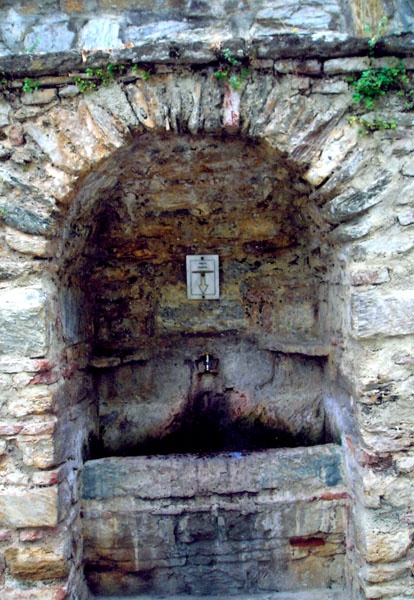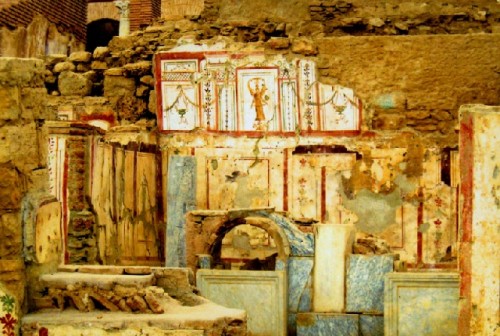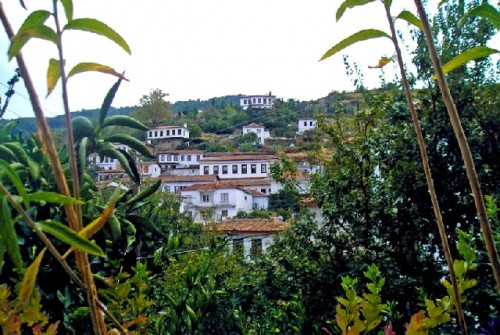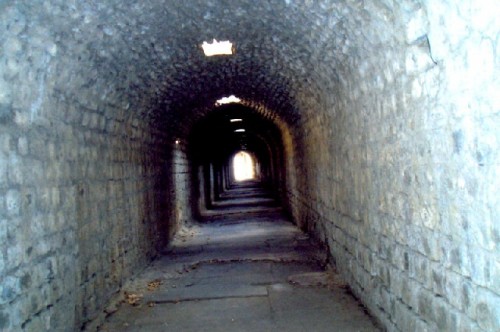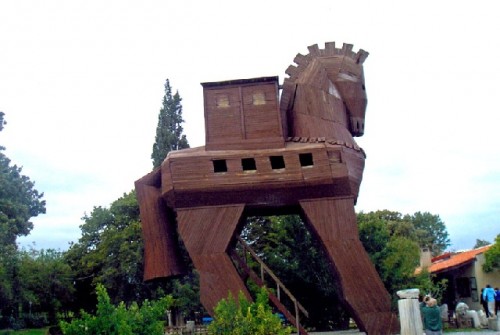Travels in Turkey
Kusadasi, Ephesus, Pergamum and Canakkale
By: Zeren Earls - May 20, 2007
Kusadasi (Bird Island)
This is a seaside resort town and base for excursions to the ancient cities nearby. Many cruise ships on Greek island tours stop here, affecting both the town's appearance and its markets for trinkets. The town is named for a small island, now connected to the mainland by a causeway. We were fortunate to stay in a hotel right on the water and away from the markets. Owned by the granddaughter of the last Sultan Vahdettin, it was a gift to her by her landowner husband, whom she met in the US during the family's exile from Turkey. All dairy products and honey served at the hotel come from the family farm.
Our excursion of the area began with Virgin Mary's House, a shrine accepted in the 60s by the Pope as a place for pilgrimage. It is believed that she came with St. John the Apostle, lived and died here. The house is located within a memorial park on a rolling hill. A footpath lined with olive trees, trunks painted white to keep bugs away, leads to the stone house, which has a prayer altar and a fountain with holy water. On sale are white strips of cloth for tying onto wall-length screen fences to express a wish. The strips maintain uniformity of color and size, contributing to the contemplative setting.
As we walked downhill, workers cut and stacked wood on scorched hills – the result of forest fires set by the PKK, the Kurdish rebel organization. Last summer they started seventeen forest fires near tourist areas, in order to harm the country's economy. To extinguish the fires, helicopters sprayed the pine forests with water brought from the sea. Workers' tents crowded the hillside as part of a massive reforestation effort.
We continued on to Ephesus, an ancient city first settled in 3000 BC. A great trading and religious city, it was the center of the cult of Cybele, an Anatolian fertility goddess. Fleeing an invasion by the Dorians in 1000 BC, Ionian colonists came and replaced Cybele with Artemis, building a temple in her honor. When the Romans took over and made it the province of Asia, Artemis became Diana and Ephesus became the Roman provincial capital (1st and 2nd century AD), which is the city we visit today.
Once a large and busy Roman port town with a population of 250,000, Ephesus has very impressive ruins. The marble street where Paul walked and the theater where he faced a rioting mob attract the most attention. The theater that seats 24,000 and the agora are the largest the Romans ever built. There is a magnificent two-story library supported by marble columns and adorned with recessed statues. The temple to Hadrian, the baths, the public toilets, the city council chambers and the gymnasium are other buildings of note. What I marveled at most was the terrace houses currently under restoration. These are peristyle homes with caryatid-figure columns surrounding a courtyard. The walls are decorated with marble panels and fresco portraiture. The floors are carpeted with mosaics – chunky pieces on the edges and fine pieces for the medallion. Our tour ended at the Ephesus Museum, the highlight of which was the statue of Diana, the fertility goddess.
The village of Sirince, 11 km uphill from Ephesus, was our afternoon treat. Formerly a predominantly Greek village, it lies in a bowl of hills surrounded by peach orchards, vineyards and olive groves. The village has retained its authentic 19th-century look of small white houses with red tiled roofs stacked against the hill. We called ahead for made-to-order lunch in a home restaurant called "Gözlem". Stuffed squash flowers and manti (Turkish ravioli with garlic yogurt) were among the specialties we enjoyed. At my request they even purchased fresh figs. Recent tourism has brought souvenir shops to this village of 600. All the shop owners know one another and direct one to the right place depending on what one is looking for. Following a tip by American friends who had previously visited Sirince, I was able to locate a shop that specialized in jewelry combining semiprecious stones with needlepoint motifs – truly a unique find.
Heading north to ancient Pergamum, we passed by Izmir, Turkey's third largest city
(3 million) and a major port for export. Likewise a city steeped in history, Izmir (Smyrna) has unfortunately turned into a busy, cluttered metropolis with a labyrinth of industrial plants and shanty towns. I was saddened to see that the hit-or-miss expediency in the growth of many Turkish cities had claimed this one too, suffocating its dignity of old.
We also passed by Aliaga, a town wealthy because of its refineries. Turkey imports and refines fuel oil. Following roads by the coast and passing through resort towns, we arrived in Bergama.
Bergama (Pergamum) sits on a high steep hill in a rolling pastoral country of green fields. After the death of Alexander and the break up of his empire, Lysimachus claimed the region and established the capital of the Attalid Dynasty at Pergamum (131 BC). It became the second Athens, brimming with culture, its hilltop crowned with palaces and temples, and hillsides terraced with elaborate public buildings: an enormous theater, a library, schools, gymnasiums, baths and a great altar to Zeus, the statues of which are in Berlin's Pergamum Museum. (The Germans conducted the digs before World War II.) The Attalids were also patrons of the arts. They invented parchment – untanned skin of sheep or goats – as an alternative to buying papyrus from their rivals, the Egyptians.
Asclepium, a medical center for ailments of the mind or body, had a sacred spring, restoring baths, cubicles for sacred sleep and a little theater for the convalescent. Patients walked through the collonaded gallery to receive diagnosis and prescription from the gods, who interpreted dreams. They left votives upon healing. (Asclepeion is the god of healing). We noted the relief of a caduce – the wand with two serpents entwined that is the symbol of medicine. The serpent represents longevity because it renews itself by shedding its skin.
Like nimble goats we walked up and down the trails through the rubble, admiring the panoramic view. Then we descended to the town center below to the Saglam restaurant, where we enjoyed local specialties, such as hösleme, made by mixing the cheese culture of the day with semolina. The owner of the restaurant sang for us, "Fawn, stray not in these mountains; for you'll be shot and parted from your parents." The sad song turned out to be a metaphor for him; he was from Urfa in southeastern Turkey.
The road to Çanakkale was scenic with interesting stops: a refreshing mix of fresh pomegranate and orange juice was squeezed as I watched; colorful hand-woven textiles from nearby villages proved irresistible; olives and olive oil in Edremit beat Istanbul prices. Villages gave way to resort towns with apartment blocks by the water; satellite dishes blanketed the rooftops; a clever restaurant billboard read "It is not where you live but where you are fed that counts." An inland road took us by fields of roses cultivated for sale; open trucks heaped with melons and crates of tomatoes and potatoes chugged along. As night approached goats descended from the mountains; roadside stands closed down under plastic covers; people in long coats and headscarves rushed home for iftar. Then a big Trojan horse sculpture appeared by the seaside; we were in Çanakkale. Our Hotel, the Akol, managed well the tour groups, who were there to visit nearby Troy.
Çanakkale
Meaning "Clay Fortress" in Turkish, Çanakkale is strategically located at the Dardanelles across from Gelibolu (Gallipoli). The strait is named after the legendary king of Troy, Dardanos; its history is of people battling each other for control of this narrow passage, which unites the Mediterranean and Aegean with the Marmara and Black Seas. The last battle was when the British attacked Gallipoli to reach Istanbul during World War I. Under the command of Atatürk the Turks battled for eight months, losing 400,000 soldiers. 18 March 1915, the date of victory, adorns the hillside in Çanakkale.The international passage, with its rough waters and undercurrents, is now open to all.
Truva (Troy) is 32 km south of Çanakkale. It was lost to legend until Heinrich Schliemann, a German-born businessman and amateur archeologist from California, rediscovered it in 1871. He uncovered superimposed towns going back to 3000 BC. Troy used to be a coastal fishing village until the sea filled in, moving the settlement inland. The cities called Troy I-Troy V were of similar culture. The town took on a new character with Troy VI (1800-1275 BC). This was the city of Priam, which engaged in the decade-long Trojan War. According to Homer, Odysseus (Ulysses) came up with the idea of a wooden horse filled with soldiers. Another theory is that an earthquake brought down the walls in 1275 and hastened the Greek Achaeans' victory; so in gratitude to Poseidon the Earth-Shaker, they built a monumental wooden statue of Poseidon's horse.
Troy IX is the Roman city (300 BC-300 AD). The ruins are of the nine ancient cities, one on top of another. As houses with thatched roofs collapsed over time, new ones were built. The different strata are well marked. A replica of the Trojan horse sits on the site, which itself reveals few thrills. However, the semi-legendary antiquity and the beauty of the setting are well worth the visit.
Our trip continued north by the Dardanelles, and then along the southern shores of the Marmara Sea, dotted with vacation towns. The ever-changing scenery included cargo ships on rough waters, fields of purple mountain thyme, irrigated rice paddies on flat land, and harvested sunflower stalks bent by the wind. In Biga school children in uniform crowded the streets at the end of their morning shift. Road construction brought us to a crawl; our bus developed a filter problem outside of Bandirma. We decided to stop for lunch at a nearby truck stop while our driver cleaned out the filter. People were friendly; we did not seem to bother the all-male clientele. The place was clean and the food tasty.
Back on the road, we saw that small industries claimed the fields: poultry farms, food processing plants, an animal husbandry institute, furniture manufacturers, marble craftsmen and textile centers. Near Karacabey vendors sold small winter melons and honey by the roadside; we passed by a bird sanctuary. Soon after Bursa sprawled before us; the entry to "green" Bursa teemed with billboards and automobile assembly plants. We reached Çekirge, a suburb known for its thermal baths, our home for two nights.

